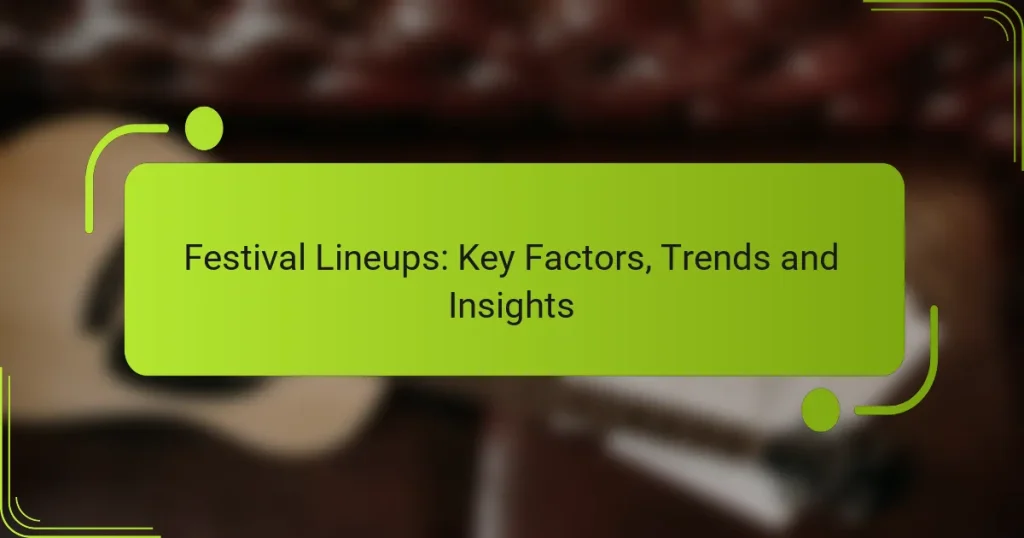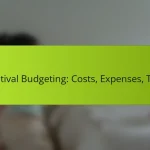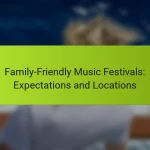Festival lineups are crucial in determining the success of an event, influenced by factors such as artist popularity, genre diversity, and audience demographics. A thoughtfully curated lineup not only enhances the festival’s appeal but also significantly impacts ticket sales and overall attendee satisfaction. As trends evolve, organizers are increasingly focusing on diversity and the inclusion of emerging music genres, alongside innovative formats like virtual performances, to meet the changing preferences of audiences.
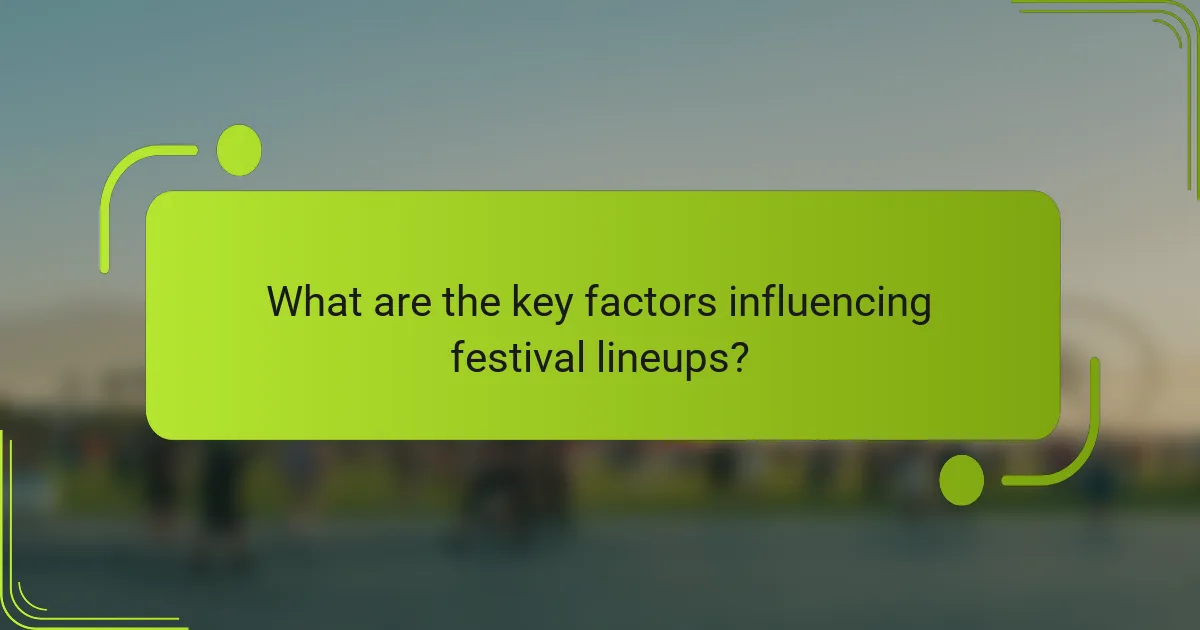
What are the key factors influencing festival lineups?
Festival lineups are shaped by several key factors, including artist popularity, genre diversity, audience demographics, budget constraints, and location logistics. Understanding these elements helps organizers create appealing and successful events that attract attendees and generate revenue.
Artist popularity
Artist popularity is a crucial factor in determining festival lineups. High-profile acts can draw larger crowds, increasing ticket sales and overall festival visibility. Organizers often analyze streaming numbers, social media presence, and recent chart performances to gauge an artist’s current appeal.
Incorporating a mix of established stars and emerging talent can balance the lineup, catering to different audience segments. For instance, pairing a well-known headliner with up-and-coming artists can enhance the festival’s reputation while providing exposure for new acts.
Genre diversity
Genre diversity plays a significant role in attracting a broader audience to festivals. A varied lineup can appeal to fans of different musical styles, enhancing the overall experience. Organizers should consider including multiple genres, such as rock, electronic, hip-hop, and indie, to create a well-rounded event.
Additionally, genre diversity can foster collaboration between artists, leading to unique performances and memorable moments. Festivals that successfully blend genres often see increased attendance and positive feedback from attendees.
Audience demographics
Understanding audience demographics is essential for tailoring festival lineups. Factors such as age, gender, and cultural background influence musical preferences and can guide the selection of artists. For example, a festival targeting younger audiences may prioritize popular pop and electronic acts.
Organizers can gather demographic data through surveys, ticket sales, and social media analytics. This information helps ensure that the lineup resonates with the target audience, ultimately leading to higher satisfaction and repeat attendance.
Budget constraints
Budget constraints significantly impact festival lineups, as organizers must balance artist fees with overall expenses. Popular artists often command high fees, which can limit the number of acts that can be booked. Careful financial planning is essential to ensure that the lineup remains attractive while staying within budget.
Organizers should prioritize spending on key headliners while considering lower-cost emerging artists to fill the lineup. This approach can create a compelling festival experience without overspending.
Location logistics
Location logistics are vital in shaping festival lineups, as the venue’s capacity, accessibility, and local regulations can influence artist selection. Festivals held in urban areas may have different logistical challenges compared to those in rural settings, affecting the types of artists that can be booked.
Additionally, local laws regarding noise levels, permits, and safety regulations must be considered when planning the lineup. Understanding these factors can help organizers create a successful event that complies with local requirements while maximizing audience enjoyment.

How do festival lineups impact ticket sales?
Festival lineups significantly influence ticket sales by shaping audience expectations and perceived value. A well-curated lineup can drive demand, while a lackluster selection may deter potential attendees.
Influence of headliners
Headliners are often the main draw for festival-goers, as they typically have established fan bases. A popular headliner can boost ticket sales substantially, sometimes increasing demand by over 50% compared to festivals without big names.
Festivals that feature multiple high-profile acts tend to sell out faster, as fans are more likely to purchase tickets early to secure their spot. It’s crucial for organizers to balance headliners with emerging artists to appeal to diverse audiences.
Lineup announcements timing
The timing of lineup announcements plays a critical role in ticket sales. Early announcements can create buzz and anticipation, leading to increased early ticket sales, while last-minute reveals may not allow enough time for effective marketing.
Typically, announcing the lineup three to six months before the event allows for optimal promotion. Festivals that wait too long risk losing potential attendees to competing events or other commitments.
Social media engagement
Social media engagement is vital for promoting festival lineups and driving ticket sales. Festivals that actively engage with their audience through platforms like Instagram, Twitter, and Facebook can create a sense of community and excitement.
Effective strategies include sharing artist spotlights, behind-the-scenes content, and interactive polls. Engaging with fans through contests or giveaways can also enhance visibility and encourage ticket purchases.

What are the current trends in festival lineups?
Current trends in festival lineups emphasize diversity, the rise of emerging music genres, and the integration of virtual performances. These factors reflect changing audience preferences and the evolving landscape of live music events.
Diversity and inclusion
Diversity and inclusion in festival lineups have become essential, with many organizers prioritizing representation across various demographics. This includes not only gender and ethnicity but also the inclusion of [censured] artists and performers from different cultural backgrounds.
Festivals are increasingly showcasing a wider range of artists, which can enhance the overall experience for attendees. For example, events like Coachella and Glastonbury have made significant strides in featuring diverse acts, appealing to a broader audience and fostering a more inclusive atmosphere.
Emerging genres
Emerging genres are gaining traction in festival lineups, reflecting the evolving tastes of music fans. Genres such as electronic dance music (EDM), indie pop, and hip-hop are becoming more prominent, often blending with traditional styles to create unique experiences.
Festivals are now curating lineups that highlight these new genres, attracting younger audiences who seek fresh sounds. Events like Lollapalooza and Primavera Sound are known for their commitment to showcasing innovative artists and genres, making them popular among trendsetters.
Virtual performances
Virtual performances have transformed how festivals operate, especially after the pandemic. Many festivals now offer hybrid models, combining in-person events with online streaming options to reach a wider audience.
This trend allows fans who cannot attend physically to enjoy performances from the comfort of their homes. Festivals like Tomorrowland and Bonnaroo have successfully implemented virtual components, providing access to exclusive content and interactive experiences for global audiences.
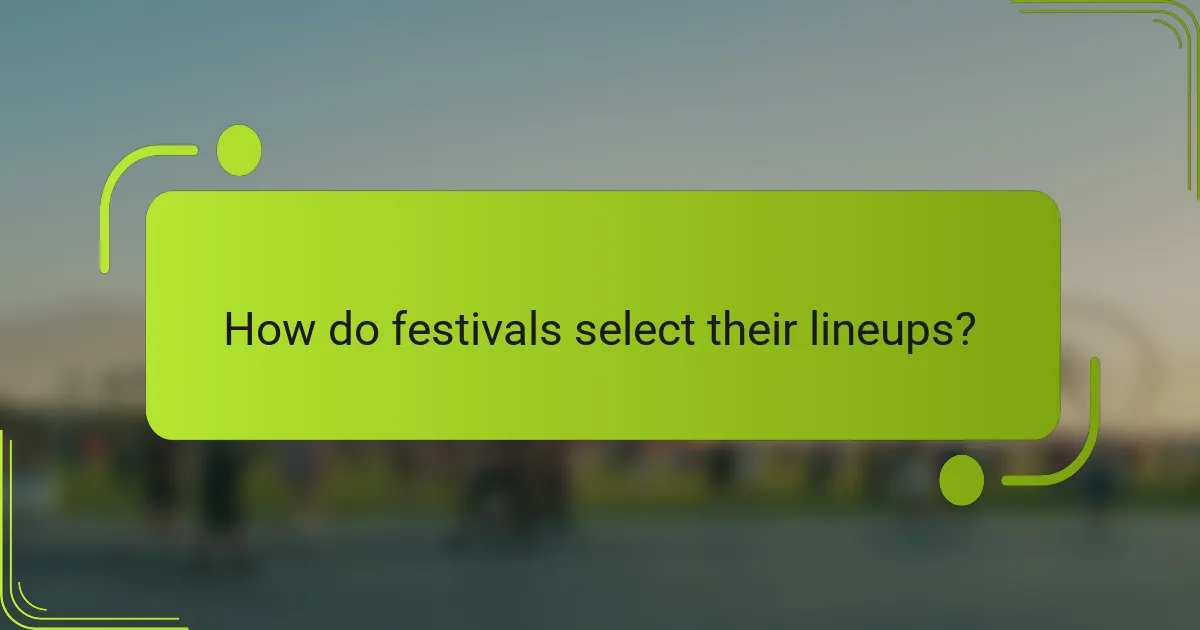
How do festivals select their lineups?
Festivals select their lineups through a combination of strategic planning, audience insights, and industry connections. The process involves collaboration with booking agents, gathering audience feedback, and conducting market research to ensure a successful event that resonates with attendees.
Booking agents’ roles
Booking agents play a crucial role in the lineup selection process by leveraging their industry connections to secure artists and bands. They negotiate contracts, manage schedules, and ensure that the selected acts align with the festival’s vision and budget. Festivals often rely on agents’ expertise to identify emerging talent and popular headliners that can attract larger audiences.
For instance, an agent may suggest a mix of well-known artists and up-and-coming performers to create a diverse lineup that appeals to a broad demographic. This balance can enhance ticket sales and overall festival experience.
Audience feedback
Gathering audience feedback is essential for festivals to understand their target market’s preferences. Surveys, social media polls, and ticket sales data can provide insights into which artists fans want to see. Festivals that actively engage with their audience are more likely to curate lineups that resonate with attendees.
For example, a festival might analyze past ticket sales to determine which genres were most popular and adjust future lineups accordingly. This approach helps ensure that the festival remains relevant and appealing to its audience.
Market research
Market research involves analyzing trends within the music industry and festival landscape to inform lineup decisions. Festivals often study competitor events, ticket pricing, and demographic shifts to identify successful strategies. This research helps festivals position themselves effectively in a crowded market.
For instance, a festival might look at the popularity of certain genres in specific regions and tailor its lineup to reflect those trends. By staying informed about market dynamics, festivals can enhance their appeal and maximize attendance.
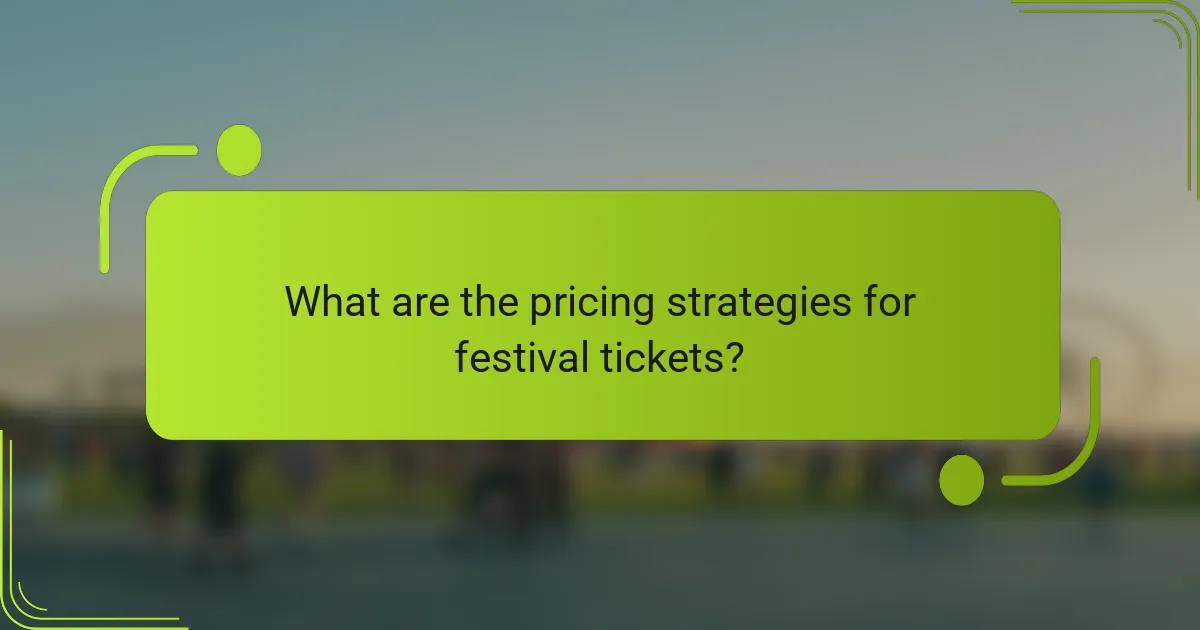
What are the pricing strategies for festival tickets?
Festival ticket pricing strategies often include various approaches to attract attendees while maximizing revenue. Common methods include early bird pricing, tiered pricing, and dynamic pricing, each designed to cater to different audience segments and purchasing behaviors.
Early bird pricing
Early bird pricing offers discounted tickets to those who purchase well in advance of the festival date. This strategy incentivizes early commitment from attendees, helping organizers gauge interest and secure initial funding for event planning.
Typically, early bird tickets can be priced 10-30% lower than standard tickets. For example, if a general admission ticket costs $100, early bird tickets might be available for $70-$90. This pricing model not only rewards proactive buyers but also helps festivals manage cash flow early on.
When implementing early bird pricing, it’s crucial to set clear deadlines and communicate them effectively. Failing to promote the urgency can lead to missed sales opportunities. Organizers should also consider limiting the number of early bird tickets to create a sense of exclusivity and urgency among potential attendees.
